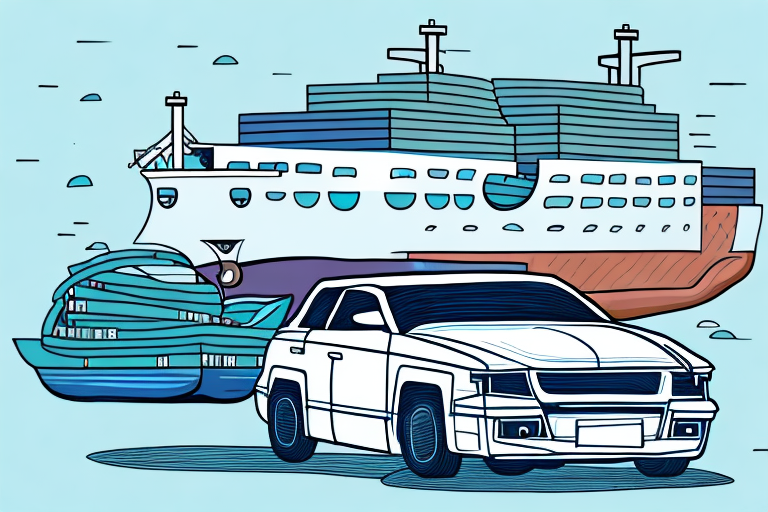If you’re considering taking your automotive business international through the export of cars, it’s important to understand the intricate process involved. This encompasses everything from establishing if your vehicle qualifies for export to selecting an optimal shipping strategy. You must also ensure that you adhere to customs regulations and secure suitable insurance coverage for your automobiles. As a car dealer, collector, or manufacturer intent on mastering the art of exporting cars, our guide aims to provide clear and direct information – no fluff included – empowering you with crucial insights needed for prosperous overseas operations in car exporting.
Key Takeaways
Export eligibility of vehicles hinges on title status and compliance with U.S. Customs and Border Protection requirements, with required documentation presented at the port of exportation to ensure a smooth process.
The Automated Export System (AES) is a critical digital platform for filing Electronic Export Information (EEI); non-citizen exporters must utilize a licensed U.S. agent for AES filing, and an Internal Transaction Number (ITB) is mandatory for the export to proceed.
A comprehensive documentation portfolio, including government-issued ID, certificate of title, bill of sale, and in some cases a lien release, is crucial for exporting vehicles, alongside adherence to the 72-Hour Rule for document submission to Customs.
Determining Vehicle Export Eligibility

Commencing your export journey requires confirming whether the vehicle in question is qualified to be exported. The status of the title of the vehicle plays a crucial role in this determination. This document serves not merely as paper but as an essential passport for your car to traverse international frontage lines.
As delineated by U.S. Customs and Border Protection, any used motorized means of conveyance assumes such designation when it passes from being under control or ownership—from its originator, merchant, or wholesaler—to that ultimate consumer known as the purchaser. Ensure smooth transit through border protection by presenting both your automobile and all requisite formal paperwork at the designated port intended for exporting vehicles while adhering strictly to established protocols.
It’s important to recognize that neglecting adherence to these export necessities and import directives could lead to punitive measures. Thus vigilantly steering clear from such scenarios is advisable.
Navigating the Automated Export System (AES)

When exporting a vehicle, one must utilize the Automated Export System (AES), an online mechanism dedicated to regulating the export of merchandise across international frontiers. Situated within the broader framework known as the Automated Commercial Environment (ACE), AES serves as an essential tool for submitting Electronic Export Information (EEI) concerning your automobile exports. It provides direction in identifying appropriate commodity classification codes for pre-owned vehicles according to specifications found in Appendix U of the AES Trade Interface Requirements.
After you have successfully submitted an EEI via AES, it generates an Internal Transaction Number (ITN) that is vital for operations carried out by U.S. Customs and Border Protection at various entry points which ensure smooth trading processes while upholding immigration and customs statutes. Non-U.S. citizens intending to export vehicles are required to engage a certified U.S. agent who acts as their navigator through this process, responsible for filing on their behalf and verifying adherence to maritime trade regulations during vehicle export activities.
AES Filing Requirements
When completing the Automated Export System (AES) documentation, compliance with established protocols is imperative. The narrative of every vehicle is inscribed in its own Vehicle Identification Number (VIN) or Product Identification Number (PIN). These crucial identifiers are indispensable for AES submissions as they uniquely distinguish each vehicle. Alongside evidence of ownership, these identifying numbers provide a coherent story and confirm undisputed possession within your AES filing.
It’s important to remember that obtaining an Internal Transaction Number (ITN) is critical to this procedure – without which you cannot initiate the process of exporting your vehicle.
Selecting an Authorized Agent
Exporters who are not U.S. citizens must engage a reliable authorized agent to manage the AES filing on their behalf. This individual plays a critical role, acting as your representative in navigating the complexities of U.S. export regulations and ensuring that all paperwork for shipping your vehicle is compliant and processed efficiently. Their expertise should cover not only procedures related to AES, but also an understanding of customs regulations more broadly, providing assistance with documentation and logistical challenges that might otherwise be daunting.
It’s imperative to rigorously check the credentials of any potential agents just as carefully as you would examine a treasure map, confirming they have licensure as customs brokers and possess a track record of successful undertakings – in other words, previous filings conducted without issue.
Preparing Your Documentation Portfolio

Begin by gathering the necessary paperwork for your vehicle sale and export process. You’ll need to assemble a set of crucial documents, which include your valid government-issued ID, the official certificate of title, and the bill of sale. These form an essential trio required to proceed with exporting your vehicle.
In situations where there’s an existing lien due to financing or leasing on the car, you must obtain either a lien release or authorization for export from the holder of that lien. This critical piece of documentation should feature an original signature from an authorized representative on company letterhead. It has to provide specific details about the vehicle and include contact information while serving as both recall clearance letter and formal permission allowing you legally transfer ownership abroad.
Securing Proper Title Documents
When it comes to exporting a vehicle, the documents related to your car’s title hold significant importance, akin to an authoritative edict. The original certificate of title is not merely a document. It serves as the definitive validation of your equitable or legal claim over the vehicle for customs authorities. For those vehicles pledged under U.S. jurisdiction, one must submit either the authentic Certificate of Title or its Certified Copy and provide two full duplicates as necessary submissions to satisfy bureaucratic procedures.
Bill of Sale and Additional Proofs
The bill of sale is an essential document that chronicles the transfer of your vehicle’s ownership and is a necessary part of the car export process. In cases where the car has neither been titled nor registered, the importance of the bill of sale increases substantially. It must be presented along with a statement from the owner verifying both a legitimate transaction and clarity about its theft-free status, as well as matters relating to sales tax.
It’s important to note that ownership verification requirements can differ across states in America. You should ascertain that all documents are correctly prepared to prevent any unexpected issues when you arrive at the port for exporting your vehicle.
Understanding Customs Regulations and Export Procedures

Grasping the intricacies of customs regulations and export protocols is crucial when you’re getting ready for international shipping. The vigilant scrutiny from Customs will encompass a thorough check on your vehicle’s documentation, ensuring their authenticity with exceptional attention to detail.
It is important to be aware that procedures can vary at different U.S. Customs and Border Protection ports, where there might be a preference for original documents over copies or particular requirements regarding how these documents should be submitted – some may require fax submissions rather than email.
The 72-Hour Rule
The 72-Hour Rule mandates that your vehicle must be present in the U.S. for at least three days before beginning its export journey, irrespective of whether it will travel by air or sea. You are required to provide all necessary documentation to Customs a minimum of three days before departure and ensure that your vehicle is available at the prearranged time. This requirement also holds true if your vehicle is departing via land. You must submit all paperwork no less than 72 hours beforehand and have the vehicle ready when it’s time to cross the border.
Adhering strictly to this rule is critical—both VIN and ITN need dispatching to the designated port of export well within those crucial 72 hours preceding exportation—to avoid any possibility of delay that could result in your car remaining idle onshore while others embark on their voyage.
Dealing with Leased or Financed Vehicles
When you’re planning to export a leased or financed vehicle, including those with foreign titles, it is imperative that you obtain explicit written consent from the interested third party or lienholder. This authorization must be presented on the letterhead of the third party and serves as an essential clearance that allows your vehicle to legally depart for international destinations. Without this official endorsement, your vehicle is not permitted to vacate its local station.
In cases where permission for exporting is denied by the lender, settling any outstanding debt becomes necessary in order to remove any restrictions preventing your car from leaving its domestic port. Only by paying off the remaining balance can you release your automobile from its financial ties and proceed with exportation from the designated port.
Insuring Your Vehicle for International Transit

When preparing your vehicle for export, it is essential to consider the significance of obtaining import/export insurance. This type of insurance acts as a pivotal layer of protection akin to an experienced navigator, offering security against unexpected challenges encountered during international transit. It effectively provides coverage against potential financial losses due to buyer non-payment and safeguards your vehicle from damages incurred while in transit, along with mitigating risks associated with unforeseen political issues that may emerge in the destination country.
In case the shipping process includes maritime routes or various modes of transportation for your car, securing marine insurance can be invaluable. Marine insurance offers comprehensive protection throughout every stage and mile over water – ensuring that regardless of where your journey leads you through shifting currents and uncertain terrains. Both you and your vehicle are covered under its protective umbrella.
Choosing the Right Shipping Method
Selecting an appropriate method for transporting your vehicle is a critical step in organizing its export. When the destination is relatively close, such as to our adjacent neighbor Canada, land freight serves as a reliable option. In contrast, ocean and air freight are preferred means of conveyance for cars destined for far-flung locales across vast seas.
If you’re seeking simplicity in shipping processes, consider using Roll On/Roll Off. Off service which allows your car to be driven on and off the carrier vessel directly. If individual protection or mass transport is required for either one car or several vehicles at once, enclosed 20-foot containers and larger 40-foot options provide secure space that ensures both safety and logistical efficiency during transit.
Evaluating Freight Forwarders
Opting for a freight forwarder when exporting vehicles is akin to assembling an elite squad for your cargo mission. The echoes of their past expeditions and the voices of their clients serve as testimonials to their prowess in steering through the complex waters of car exportation. These adept navigators bring forth a plethora of valuable services that include:
Precise packing of shipments
Effortless navigation through customs
Management and oversight of necessary documents
Monitoring, warehousing, and transporting goods
All these facets are indispensable components in ensuring smooth operations during the cars exporting endeavor.
When considering the financial investment against this array or map full services provided by them, be vigilant. Hidden costs can sometimes sneak into view like unseen shoals under clear waters.
Preparing Your Vehicle for Shipment
Before commencing its transport, it’s important that your vehicle is suitably prepped. Follow these directives:
Conduct a comprehensive wash of the vehicle to disclose its actual state and confirm an honest evaluation of any damage already present.
Ensure you remove all personal or custom items from within. Should you be using a container for shipping, then personal belongings may be packed away inside.
Make sure the battery has been charged completely.
Switch off any alarm systems installed in the vehicle.
See that the tires are filled with air appropriately.
Keep fuel levels down to about 1/8th of the tank capacity ensuring secure maritime conveyance.
In case your self propelled vehicle exhibits peculiar mechanical behaviors, make sure to document them thoroughly and pass on specific instructions for operation to the shipping company so as to prevent complications during transit. It is also beneficial to provide them with a declaration from the manufacturer for added reference purposes regarding operational procedures.
Summary
As our journey through the art of exporting cars draws to a close, remember that the key to a successful venture lies in understanding and meticulously following each step of the process. From confirming your vehicle’s eligibility to navigating the AES and securing the proper documentation, to choosing a reliable freight forwarder and preparing your vehicle for its international trek — each step is a critical waypoint on the map to successful vehicle exportation. Let this guide be your compass, and may your vehicle’s journey across borders be as smooth as the calmest sea.
Frequently Asked Questions
What is the Vehicle Identification Number (VIN), and why is it important for exporting a vehicle?
When exporting a vehicle, it is imperative to incorporate the Vehicle Identification Number (VIN) in the AES filing as it serves as a critical identifier of the vehicle’s identity and ownership throughout the exportation process.
Can a non-U.S. citizen file for vehicle export without an authorized agent?
No, individuals who are not citizens of the United States are required to designate an authorized agent within the U.S. to ensure adherence to American export regulations.
What happens if I don’t comply with the 72-Hour Rule before exporting my vehicle?
Failing to observe the 72-Hour Rule prior to exporting your vehicle may result in holdups during the export procedure because Customs requires this period for document verification and vehicle inspection.
To prevent avoidable delays, it is crucial to conform with this rule.
Is it necessary to insure my vehicle for international shipping?
It is essential to secure insurance for your vehicle when shipping internationally, as it offers monetary coverage against a range of hazards encountered during transportation, failure of buyers to make payment, and political disturbances in the country of destination.
What should I do if my vehicle has a mechanical issue before shipping?
It is crucial to record all mechanical problems and convey precise instructions for operation to the company responsible for shipping your vehicle. This step will assist in safeguarding against any additional harm that could occur while your vehicle is in transit.


